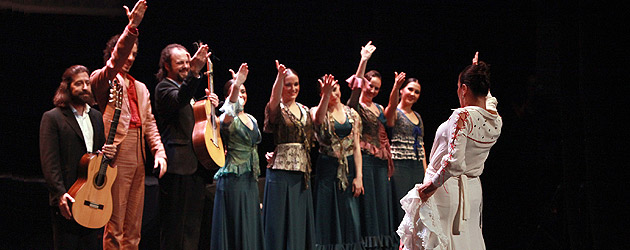Text: Estela Zatania
Photos: Ana Palma
XVIII FESTIVAL DE JEREZ
Ballet Flamenco de Andalucía “En la Memoria del Cante: 1922”
Antonio Rey “Camino al Alma”
Friday, February 28th, 2014. Jerez de la Frontera
Special 18th Festival de Jerez – All the information
ANTONIO REY “CAMINO AL ALMA”
Sala Paúl, 7:00pm
Festival de Jerez, February 28th, Andalusia Day, holiday and a day of mourning for Paco de Lucía. Antonio Rey, one of the most brilliant young guitarists of the current scene, prize-winner at La Unión, at the Córdoba contest, the Giraldillo of the last Bienal de Sevilla and one of Paco’s spiritual children. The musician came on stage at the Sala Paúl, remained standing in silence and bowed his head for one minute. Applause.
Although he came on alone, the stage was prepared for a sextet, one of the many legacies of the Maestro. When Rey agreed to play at the Festival de Jerez to present his new record “Camino al Alma”, little did he know that his recital would end up being a tribute to Paco de Lucía. He opened with taranta, as Paco so often did, and each note was full of the latter’s genius, reminding us all just how much we owe him. Among other pieces, he interpreted “Cuando Canta el Gallo”, based on the first soleá Paco ever recorded explained Rey, hurriedly prepared the day before in his honor.
After three solo pieces, the rest of the group came on to interpret themes from the new recording: second guitar Manuel Urbina, percussionists Ané Carrasco and Ález Fernández, electric bass Pepe Pulido and Mara Rey and young José Triviño for vocals and palmas. Antonio spoke between pieces: “It’s very hard to play with what’s happened…Paco always helped us young people…he is in every note”.
The excellent recital was rounded out with the bulerías of guest artist, singer Jesús Méndez.
BALLET FLAMENCO DE ANDALUCÍA “EN LA MEMORIA DEL CANTE: 1922”.
Teatro Villamarta 9:00pm
Artistic director: Rafaela Carrasco. Soloists: David Coria, Ana Morales, Hugo López. Dancers: Alejandra Gudí, Florencia O’Ryan, Laura Santamaría, Paula Comitre, Carmen Yanes, Eduardo Leal, Antonio López, Alberto Sellés. Cante: Miguel Ortega, El Londro. Guitar: Juan Antonio Suárez “Cano”, Jesús Torres. Choreography: Rafaela Carrasco, David Coria, Ana Morales, Hugo López. Music: Antonio Campos, Juan Antonio Suárez “Cano”, Jesús Torres. Off-stage voice: Francisco Suárez.
Upon entering the Villamarta theater and seeing smoke in the air, I asked the usher if there might be a fire, but was told it’s part of the show. The new production of the Ballet Flamenco de Andalucía, under the direction of recently named head Rafaela Carrasco, aims to evoke the Concurso de Cante Jondo (flamenco singing contest) held in Granada in 1922.
You also hear old-time recorded music, and the dancers’ wardrobe is right from the era. But when they begin to move, it’s with robot-like geometric movements that imitate the modern dance that Rafaela is so fond of. An off-stage voice explains the idea behind the contest, but with the abundant footwork, little can be heard.
The following number is more creative but equally surreal. Singers Chacón, Torre and Pastora Pavón are represented dancing their most representative cantes…for example, caracoles and cartageneras of Chacón, bulería por soleá and bamberas of Pastora, bulerías and siguiriyas of Torre… It’s what’s known as “suspension of disbelief” that forms the basis of all plays; even though there is little or no relation to reality, the music and dance are entertaining. The same can be said of Ramón Montoya’s famous rondeña interpreted by Jesús Torres…and danced by three men and three women, even though the danced rondeña has nothing to do with this lyrical guitar solo.
And heaven forbid some reciting of Lorca’s poetry would be left out. Following this, energetic siguiriyas danced by Hugo López. But not to worry, things pick up and the first enthusiastic applause is heard for a sort of Granada suite that includes the cachucha, fandango del Albayzín, the mosca and a brief taranto as pretext for tangos de Granada.
Ana Morales danced to a saeta of Pastora with seven other dancers, another odd number that wasn’t as bizarre as it sounds. Through it all, Miguel Ortega does a fine job, and Londro holds his own. Both singers take turns with tonás, and there’s lots and lots and lots and lots of heelwork, another trademark of the new director of the company.
Yet another curiosity, a malagueña of Chacón is danced by Alberto Sellés, then, granaína, and you can’t imagine how strange it is to hear “Engarzá en oro y marfil” to rapid abandolao compás. Miguel Ortega sings soleá apolá to an “audience” made up of the company, who listen attentively. This is meant to represent old Tenazas, one of the winners of the contest.
Rafaela Carrasco saves herself for the end, and offers the best dance moment of the work. With a portrait of la Macarrona as backdrop, she dances the latter’s alegrías, and manages to do it without looking like a parody. A very effective representation of the rain that surprised them that day back in 1922, done with the clever projection of lights, triggers the audience’s admiration and thus ends this work of the Ballet Flamenco de Andalucía.
Ballet Flamenco de Andalucía – En la memoria del cante 1922
Antonio Rey – Festival de Jerez
